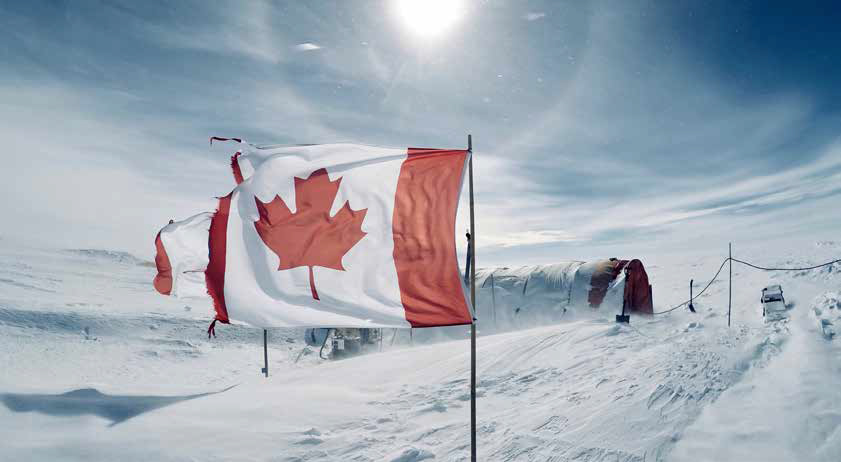The State of Canada's Ice Core Archive
Editor's note: Glaciers are excellent indicators of change. In fact, the history of ancient climate is embedded in the ice, quite literally. Ice cores are one of the best repositories of information on past climates and past environments. Glaciers preserve climate records very much like tree rings, for example. Do you know how glaciers are formed? Snow is added to the top; over time, it is compressed and turns into ice; and ice-core scientists then can drill holes, pull out a core, and examine what’s there. And what’s there can actually tell us a lot.
Because of climate warming, however, those records are being eroded, and they’re disappearing. In an effort to try to understand our changing glaciated landscape in the face of climate change, the Canadian Ice Core Archive (CICA) provides an opportunity for researches to gather data and observe ice cores in a controlled environment.
Martin Sharp and Alison Criscitiello from the University of Alberta provide us with a history on Canadian core sampling efforts, an introduction to CICA's goals and facilities, and their ongoing projects.
This article first appeared in the ACC's 2018 State of the Mountains Report. We'll continue to publish articles exploring the science of the current state of Canada's alpine on our blog throughout the year. Find them all here.
Canada, a proud part of the 2017/18 Antarctic deep drilling program in Wilhelm II Land. Photo: Alison Criscitiello.
Past & Current Core Sampling
A number of ice cores have been drilled through ice caps and glaciers in the Canadian Arctic Islands and on Mount Logan since the first one was retrieved from the Meighen Ice Cap in 1965. Sadly, the Meighen Ice Cap is now on the verge of disappearing as a result of high melt rates in recent decades.
Drilling for ice core samples.Photo: Alison Criscitiello.
Most recently, coring activities have been led by scientists from the Geological Survey of Canada (GSC) - some also involving collaborators from Canadian universities as well as other countries. A significant collection of ice cores, totalling ~1.5 kilometres in length was built up as a result, and some of these cores incorporate ice that was formed during the last continental glaciation of North America more than 20,000 years ago. Sites cored include the Devon Island Ice Cap, the Agassiz Ice Cap and Prince of Wales Icefield on Ellesmere Island, Mount Logan, and the Penny Ice Cap on Baffin Island (the last vestige of the Laurentide Ice Sheet).
Ice core sample. Photo: Alison Criscitiello.
To accommodate and manage the collection and facilitate research on the cores, a new storage and analysis facility, the Canadian Ice Core Archive (CICA), was constructed on the University of Alberta (UA) North Campus, with funding from the Canada Foundation for Innovation and the Government of Alberta.
WHAT IS CICA?
CICA is managed by its Technical Director, Dr. Alison Criscitiello, and Scientific Director, Dr. Martin Sharp, and is intended to be a national facility available to any qualified researcher who has a scientific interest in the material held in the collection. The facility consists of a -40°C storage freezer where the cores are kept, a -20°C working freezer where cores will be imaged and processed prior to analysis, and a room temperature analytical laboratory, where chemical and other analyses of core samples can be performed.
CICA also has partnerships with a range of other chemical and biological analytical labs on campus that will allow a diverse array of research to be conducted, including climate variability and change, aerosol and particulate (dust and volcanic ash) deposition from the atmosphere, the depositional history of organic and inorganic contaminants (i.e. black carbon, heavy metals and organochlorine compounds), and the microbiology and biogeochemistry of glacier ice.
Alison Criscitiello and her Australian and Danish team, drilling to 300m in East Antarctica, Christmas Day, 2017.
Present coring PROJECTS
One goal of CICA will be to undertake new coring activities that will allow us to grow the core collection and be involved in international ice coring activities. During the winter of 2017-18, for example, Alison Criscitiello served as a driller on an Australian project to collect new deep ice cores from the rarely visited Indian Ocean sector of Antarctica, and she will join colleagues from the University of Maine within the next couple of years to drill new cores on Mount Logan.
Discussions are also underway for new drilling on Ellesmere Island with US and UK colleagues, and there is a possibility of drilling in the Canadian Rockies as part of the international “Ice Legacy” project (led by U. Grenoble, France) which aims to collect pairs of ice cores from glaciers around the world that are shrinking rapidly and may disappear within the foresee-able future. Shallow ice coring carried out on four ice caps in the Canadian high Arctic over the past three years, led by Dr. Criscitiello, will help lay the groundwork for future deep coring efforts in these under-studied regions.
Future Goals and CLIMBERS
We continue our efforts to sample and analyze new cores in hopes to better understand our changing icecaps and glaciers - it may be possible to engage the climbing community in efforts to manually sample the faces of more difficult to reach ice cliffs in locations such as Snow Dome, where lengthy records of snow and ice accumulation are directly exposed.




